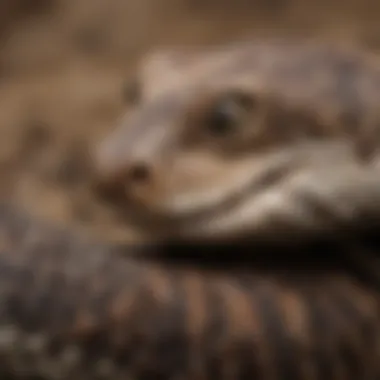The Snakes of Arizona: An In-Depth Examination


Intro
Arizona is a state known for its stunning desert landscapes and rich biodiversity. Among its diverse ecosystems, snakes are a significant group of reptiles that highlight the ecological balance of the environment. Arizona hosts a wide array of snake species, each uniquely adapted to thrive in varied habitats ranging from arid deserts to lush riparian zones. Understanding these snakes is essential not only for wildlife enthusiasts but also for conservationists and the general public. In this examination, we will explore key aspects of Arizona's snake species, including their unique characteristics, behaviors, ecological roles, and the conservation challenges they face.
Fascinating Facts About the Animal
Unique Characteristics
Arizona's snakes exhibit a remarkable range of adaptations that enable them to survive and thrive in their specific environments. For instance, the eastern diamondback rattlesnake possesses distinctive diamond-shaped patterns along its back, serving as camouflage within the rocky terrains.
Many species, like the gopher snake, can mimic the appearance of more dangerous rattlesnakes. This adaptation helps them deter potential predators. Furthermore, the color variations among snake species can often indicate their habitat preferences, showcasing a fascinating link between appearance and environment.
Extraordinary Abilities
These snakes have evolved extraordinary abilities that aid in their survival. Their advanced sensory organs allow them to detect heat, which is crucial for hunting warm-blooded prey. For example, the western diamondback rattlesnake uses heat-sensing pits located on its face to identify and strike accurately at its prey, even in complete darkness.
Additionally, many snake species have developed venom that serves various purposes. Some venom is neurotoxic, affecting the nervous system of their prey; others are hemotoxic, impacting their blood and tissues. Each venom type reflects the snake's ecological niche, indicating a complex evolutionary history.
"Understanding snake biological adaptations is crucial for appreciating their role in the ecosystem and their importance in maintaining balance."
Behavior and Habitat
Natural Habitats
The habitats of Arizona's snakes vary widely, ranging from sandy deserts to rocky hillsides to lush wetlands. The desert regions often host species like the Arizona coral snake, which is adapted to the arid climate with its striking coloration that warns predators of its venomous nature.
On the other hand, the garter snake is commonly found near water sources, thriving in riparian zones where food is abundant. Understanding these habitat preferences is critical for field studies and conservation efforts.
Social Structures
Most snakes in Arizona are solitary animals, but they do exhibit interesting social behaviors during mating seasons. While they do not form long-term social structures, certain species, like the rattlesnake, may congregate in groups during the breeding season or when hibernating.
Their social interactions are largely driven by instincts and reproductive needs. While they may not display complex social behaviors, their movements and interactions still reflect important aspects of their life cycle.
Recent Scientific Discoveries
Latest Research Findings
Recent studies have illuminated various aspects of snake biology and ecology in Arizona. For example, researchers have begun to explore the effects of climate change on snake populations. Changes in temperature and precipitation patterns could influence their distribution and reproductive cycles.
Breakthroughs in Animal Biology
A notable discovery includes advances in understanding snake venom. Genetic analysis has unveiled the complexities of venom composition and its variations among species. This research not only expands our knowledge of snake biology but also has potential applications in medicine for developing antivenins and other therapeutics.
Cultural Significance
Animals in Folklore
Snakes have played a significant role in the folklore of Arizona. Indigenous cultures often view certain snakes as symbols of power and transformation. Their presence in stories reflects deep cultural meanings, emphasizing respect for nature.
Influence on Art and Literature
Moreover, snakes have influenced art and literature significantly. Artists and writers have drawn inspiration from their intriguing characteristics and symbols, marking their place in cultural narratives. The complexity of these narratives reinforces the importance of understanding snake behavior and biology.
Overview of Snakes in Arizona
Understanding the snakes of Arizona is vital for appreciating the biodiversity of this region. Arizona is home to a diverse range of snakes, which inhabit various ecosystems across the state. This article will delve into their roles within these ecosystems, their behavioral patterns, and the challenges they face due to human activity and environmental change.


Snakes play crucial roles in maintaining ecological balance. They are predators and help control populations of small mammals and insects. This helps prevent the spread of diseases and can influence plant growth indirectly through controlling herbivorous species.
Importance of Snakes in Ecosystems
The ecological significance of snakes cannot be overstated. As apex predators, they play a pivotal role in managing the populations of their prey. Without snakes, there would likely be an overabundance of certain species, leading to habitat degradation and shifts in ecosystem dynamics.
- Predator-Prey Relationships: Snakes help maintain balance within their habitats by regulating populations of rodents and insects. This prevents overgrazing and allows for healthier plant life.
- Biodiversity Indicators: The presence of a healthy snake population indicates a well-balanced ecosystem. A decline in snake species can be a warning sign of environmental distress.
- Nutrient Cycling: Their predation contributes to nutrient cycling. As snakes consume prey, they facilitate energy transfer within the food web, impacting various other species.
"Snakes are an integral part of Arizona's ecosystems, influencing both biodiversity and the health of various habitats."
Diversity of Snake Species
Arizona boasts a rich variety of snake species, with over 50 different kinds identified. This diversity is attributed to the state's wide range of habitats, from deserts to mountains and forests. Each species has evolved uniquely to thrive in its environment.
- Native Species: Many snakes are native to Arizona, such as the Western Diamondback Rattlesnake and the Gopher Snake. Each species exhibits adaptations that enable it to survive in its particular ecosystem, such as coloration and feeding habits.
- Non-Native Species: Some non-native snakes have also found their way into Arizona, posing threats to local biodiversity. Understanding the distinctions and impacts of these species is key for conservation efforts.
- Conservation Concerns: With various species at risk due to habitat loss and climate change, it is crucial to recognize the importance of protecting these snakes. Efforts can be focused on creating protected areas and educational programs to promote coexistence.
Overall, the snakes of Arizona are not just fascinating creatures but essential components of their ecosystems. Studying their roles can lead to better conservation strategies and a more profound appreciation for the natural world.
Geographical Distribution of Snakes
Understanding the geographical distribution of snakes in Arizona is crucial. This topic highlights how various deserts, mountains, and ecosystems influence where different snake species thrive. Each region offers unique habitats, shaping the characteristics and behaviors of the snakes residing there. Knowledge of their distribution assists in conservation efforts, education, and wildlife management.
Different Regions of Arizona
Arizona is home to a variety of regions, each providing distinct environments for snakes. The major geographical areas of Arizona include the Mojave Desert, Sonoran Desert, and the high elevation areas such as the Colorado Plateau.
- Mojave Desert: This region is primarily found in the northwest part of the state. It is characterized by sparse vegetation and extreme temperatures which influence the types of snakes here, such as the Mojave rattlesnake.
- Sonoran Desert: Spanning much of southern Arizona, the Sonoran Desert offers a warmer climate with abundant flora and fauna. Species like the western diamondback rattlesnake and gopher snake inhabit this area, taking advantage of the diverse habitats.
- High Elevation Areas: The Colorado Plateau in the northern part of Arizona consists of cooler temperatures. This region supports a different set of species, such as the rubber boa and the common kingsnake, which are adapted to higher altitudes.
Each of these areas presents a unique set of ecological conditions that affect the snake populations found there.
Habitat Preferences
Snakes in Arizona exhibit specific habitat preferences based on their physiological and behavioral traits. Understanding these preferences can aid in identifying where to observe these creatures in their natural environment.
- Desert Scrub: Many snakes, such as the gopher snake and sidewinder, prefer dry habitats with little cover. They are adept at blending into rocky and sandy terrains.
- Riparian Areas: Snakes like the western diamondback can often be found near rivers or streams. These habitats provide essential resources such as water and prey.
- Forested Regions: Some snake species, like the common kingsnake, favor areas with dense vegetation. This provides them with both cover from predators and ample hunting opportunities.
Understanding these habitat preferences gives insight into their survival strategies and behaviors in Arizona's diverse ecological landscape.
"Geographical distribution indicates not only where species live, but also the interactions they have within their ecosystems."
In summary, grasping the geographical distribution and habitat preferences of Arizona’s snakes is essential. It plays a significant role in conservation efforts and helps inform the public and professionals about these unique organisms.
Common Species of Snakes in Arizona
Understanding the common species of snakes in Arizona is essential for a comprehensive appreciation of its unique biodiversity. The state’s environment fosters various snake species, each contributing to the ecological balance. Recognizing these species also aids in promoting safety and conservation awareness. Moreover, knowledge of these snakes can enhance interactions between humans and wildlife.
Western Diamondback Rattlesnake
The Western Diamondback Rattlesnake is perhaps the most iconic snake in Arizona. It can be found in diverse habitats, from deserts to scrublands. This species is easily recognizable due to its distinctive diamond pattern along its back and its characteristic rattle at the tail.
This snake plays a significant role in controlling rodent populations, which can help maintain a balanced ecosystem. Despite its venomous nature, it tends to avoid human contact. When threatened, it may display its rattle as a warning. It is important for residents and visitors to understand how to identify this rattlesnake to mitigate unnecessary fears.
Gopher Snake
The Gopher Snake is often mistaken for its venomous counterparts due to its similar coloration. However, it is non-venomous and harmless to humans. This species is often found in various habitats, including grasslands and forests. It is an effective constrictor, preying on rodents and other small animals.
Gopher snakes have a significant role in pest control. They also adapt well to their surroundings, which has made them successful in urban areas. Understanding the Gopher Snake can lead to better coexistence with wildlife and can demystify common misconceptions regarding snakes.


Coral Snake
The Coral Snake is one of the most venomous snakes in the world, yet it is often overlooked. Arizona's version has a distinct color pattern, featuring bright red, yellow, and black bands. This snake is generally elusive and prefers to hide under leaf litter or beneath rocks.
Recognizing the Coral Snake is vital for safety. It is important to note that its venom is highly potent but rare bites occur due to the snake's timid nature. Educational efforts about this species’ behavior can play a crucial role in preventing encounters and ensuring public safety.
Coachwhip Snake
The Coachwhip Snake can be identified by its long, slender body and rapid movement. This species is primarily active during the day and has a diet that includes lizards, snakes, and small mammals. Coachwhips inhabit a range of environments, including scrublands and forests.
This snake is non-venomous and often seen as beneficial to humans. Its role in controlling pest populations and its adaptability to various habitats makes it an important species in Arizona. Understandably, they can be alarming due to their speed, but recognizing their harmless nature can alleviate unnecessary fears.
The presence of diverse snake species in Arizona highlights the ecological intricacies involved in maintaining habitat balance and promoting biodiversity. Understanding these species is not just about safety; it is crucial for conservation efforts and educational outreach.
Physical Characteristics of Arizona Snakes
Understanding the physical characteristics of snakes in Arizona is essential for several reasons. It aids in identifying species effectively, given the ecological diversity. Distinct features such as scale structure, coloration, and size variations significantly contribute to their survival adaptations. This section delves into these aspects, helping to appreciate the complexity of snake biology while informing conservation efforts.
Scale Structure and Coloration
The arrangement of scales on a snake's body is not merely aesthetic; it serves several essential functions. The scales provide protection against environmental hazards, assist in locomotion, and contribute to a snake's ability to blend into its habitat. Arizona's snakes exhibit varied scale structures. Some species, like the Western Diamondback Rattlesnake, have keeled scales that enhance grip on rough surfaces, aiding in their movement across rocky terrain.
Coloration also plays a critical role in their behavior and survival. Many Arizona snakes have evolved remarkable patterns and colors that serve as camouflage. For example, the patterned coloration of the Coral Snake helps it blend into sandy and rocky environments, providing concealment from both predators and prey.
Additionally, some snakes exhibit seasonal changes in coloration. This adaptability can aid in thermoregulation and camouflage, making it easier for them to remain undetected.
Size Variations Among Species
Size is another notable characteristic among Arizona snakes. Some species reach significant lengths while others remain relatively small. The size can influence a snake’s predatory strategies and habitat preferences.
For instance, the Western Diamondback Rattlesnake can grow up to six feet long. Its size and girth allow it to prey on larger animals, such as rodents and rabbits. On the other hand, smaller species like the Chihuahuan Spotted Snake typically do not exceed two feet in length. Their smaller size grants them access to narrow crevices and underground habitats, where they find ample prey.
The size difference is also significant in mating behavior. Larger males may have a competitive edge during the mating season, as they often can establish dominance over smaller rivals. Understanding these variations helps biologists and conservationists track populations and implement effective management strategies.
Among snakes, size not only defines that physical presence but also dictates ecological roles, interactions, and nesting behaviors.
The physical characteristics of snakes in Arizona are not just matters of appearance. They encompass adaptations that reflect the demands of their environments. Understanding these traits enhances our appreciation of these creatures and underscores the importance of conserving their habitats to ensure their survival.
Behavioral Patterns
The study of behavioral patterns in snakes provides valuable insights into their ecological roles and survival strategies. Understanding these behaviors is essential for effective conservation efforts and for educating the public about these often-misunderstood creatures. Arizona's snakes exhibit a variety of behavioral traits, influenced by their environments and species-specific adaptations. Focusing on feeding habits and mating behavior, we can gain a clearer picture of how these snakes interact with their ecosystems and the challenges they face.
Feeding Habits
The feeding habits of snakes are crucial to their survival, greatly influenced by their environmental contexts in Arizona. Most snakes are carnivorous, relying on a diet of smaller animals such as rodents, birds, and other reptiles. Each species has evolved unique hunting techniques. For instance, the Western Diamondback Rattlesnake uses ambush tactics, waiting quietly for its prey to approach before striking. In contrast, the Gopher Snake practices mimicry and can often be seen "hissing" to deter potential threats while hunting.
Common feeding strategies include:
- Ambush Predation: Many snakes prefer to remain hidden and strike quickly when prey comes close.
- Active Foraging: Some species, like the Coachwhip Snake, actively search for prey by moving through their habitat.
- Constriction: Certain snakes, such as the Gopher Snake, utilize constriction to subdue their prey before consumption.
Understanding these feeding patterns is vital. They help in calculating population dynamics and in assessing the health of the ecosystems where these snakes reside. Disruption in food supply can directly impact snake populations, particularly in environments facing habitat loss.
Mating Behavior
Mating behavior is another area where the complexity of snakes can be observed. Courtship rituals vary significantly among different species. For many snakes found in Arizona, the mating season typically coincides with spring as temperatures rise, facilitating increased activity levels. During this time, males often exhibit aggressive behavior to compete for females.
Key elements of mating behavior include:


- Scent Marking: Males utilize pheromones to attract females, marking trails in their territory.
- Combat: Male snakes may engage in combat to establish dominance, showcasing their strength and fitness.
- Courtship Displays: Some species perform elaborate actions, including weaving their bodies together and producing visual signals.
The success of these behaviors has significant implications for the genetic diversity and overall health of snake populations in Arizona. As habitats change due to human activity, understanding these behaviors becomes increasingly important for conservation strategies.
"Understanding snake behavior is fundamental for effective wildlife management and public safety measures."
In summary, the behavioral patterns of feeding and mating are intrinsic to understanding the survival and ecological impact of snakes in Arizona. Each species demonstrates a fascinating array of strategies that not only ensure their survival but also contribute to the ecological balance in their environments.
Venomous vs. Non-Venomous Snakes
Understanding the differences between venomous and non-venomous snakes is crucial for anyone interested in the snakes of Arizona. This knowledge enables people to identify these reptiles correctly, which is essential for safety and conservation efforts. Knowing which species are venomous helps to instill a respect for these creatures, reducing the chances of unnecessary killing or harm. Additionally, recognizing non-venomous species can foster an appreciation for their ecological roles.
Identifying Venomous Species
In Arizona, several snakes possess venom that can be dangerous. Most noteworthy among them are the western diamondback rattlesnake, the mojave rattlesnake, and the black-tailed rattlesnake. Key features that can help identify these venomous species include:
- Rattle: Many venomous species have a rattle at the end of their tails, used primarily as a warning.
- Head Shape: Venomous snakes typically have a distinct triangular head compared to the smaller, more rounded heads of non-venomous snakes.
- Pupil Shape: A slit-shaped pupil is a common characteristic of many venomous species. In contrast, non-venomous snakes often have round pupils.
- Color Patterns: Many venomous snakes may exhibit bright colors or distinctive patterns, serving as a warning to potential predators. Familiarizing oneself with these visual identifiers is an effective way to manage encounters in the wild.
Human Safety Considerations
While the presence of venomous snakes can be alarming, human safety can be greatly enhanced through education and awareness. Here are some essential safety tips regarding encounters with snakes:
- Awareness of Surroundings: When hiking or exploring, stay alert and watch where you step or place your hands.
- Proper Footwear: Wearing sturdy boots can provide protection against snake bites.
- Avoidance: If you see a snake, it is best to leave it alone. Most snakes will not attack unless provoked.
- First Aid Knowledge: Familiarizing oneself with first aid procedures for snake bites can be lifesaving. In the case of a bite, seek medical attention promptly.
Education about venomous snakes not only ensures personal safety but also promotes coexistence with wildlife.
In summary, knowing the differences between venomous and non-venomous snakes is vital for safety and conservation goals. Through understanding and respect, we can foster a healthier relationship with the wildlife that shares our environment.
Conservation Status
In recent years, the conservation status of snakes in Arizona has become a critical subject of discussion among wildlife biologists and conservationists. Snakes play a vital role in maintaining ecological balance. They help control the populations of small mammals, insects, and other prey. Thriving snake populations indicate a healthy ecosystem. Conversely, declines in their numbers can signify environmental issues that affect various species. The assessment of conservation status allows stakeholders to understand what challenges these reptiles face and how to address them effectively.
Threats to Snake Populations
Several significant threats endanger snake populations in Arizona. These include habitat loss, climate change, and human impacts.
- Habitat Loss: Urban development, agriculture, and land conversion pose significant risks to snake habitats. As natural areas are altered for human use, snakes lose their shelter and food sources.
- Climate Change: Rising temperatures and unpredictable weather patterns can alter the delicate habitats where snakes thrive. Changes in prey availability and habitat conditions can lead directly to declines in snake populations.
- Human Impacts: Road mortality is a recurring issue. Many snakes become victims of vehicle strikes while crossing roads. This problem is exacerbated in high-traffic areas. Furthermore, illegal wildlife trade practices also threaten certain species.
Snake populations are also at risk from diseases and parasites. Factors like pollution affect their health and reproductive capabilities, further reducing their numbers.
Conservation Efforts in Arizona
Conservation initiatives in Arizona strive to protect snake species while educating the public about their importance. A few noteworthy efforts include:
- Protected Areas: Establishing wildlife reserves and parks preserves vital habitats. These areas provide safe environments where snakes can thrive without human disruption.
- Public Education: Programs aimed at educating communities about snakes help alleviate fears and misconceptions. By promoting a better understanding of snake behavior, these initiatives encourage coexistence and reduce conflicts.
- Research and Monitoring: Ongoing research is essential. Biologists track snake populations, collect data on their health, and assess the impacts of environmental changes. This information is crucial for formulating effective conservation strategies.
"Every effort made to protect snakes contributes to the overall health of the ecosystem. Their presence is a key marker of ecological integrity."
Epilogue
The examination of snakes in Arizona reveals several important aspects that are critical not only for understanding their role in ecosystems but also for informing conservation efforts. Through this investigation, one discovers that the diverse snake species in Arizona contribute significantly to the ecological balance within their habitats. From controlling rodent populations to serving as prey for larger predators, snakes are integral to ecological systems.
Summary of Key Points
- Diversity: Arizona is home to a wide variety of snake species, each adapted to different ecosystems across the state. This diversity includes both venomous and non-venomous species.
- Ecological Role: Snakes play a vital role in their environments, affecting population dynamics of other species and contributing to nutrient cycling.
- Conservation Efforts: The article discusses various threats to snake populations, such as habitat loss and climate change. Conservation initiatives are essential to protect these reptiles and their habitats.
- Human Interaction: Understanding snakes helps reduce negative encounters with humans, enabling better coexistence between people and wildlife.
Future Directions for Research
Research should focus on several key areas to deepen our understanding of Arizona's snakes:
- Habitat Studies: More detailed studies on habitat preferences will help in identifying critical areas for conservation.
- Population Monitoring: Long-term monitoring programs are needed to track the health of snake populations over time, assessing the impacts of environmental changes.
- Human-Wildlife Interactions: Investigating how humans can coexist with snakes while minimizing conflicts will be crucial as urban areas expand.
- Climate Resilience: Research into how climate change affects snake behaviors and habitats could inform conservation strategies.
Understanding the complexities of Arizona's snakes will ultimately contribute to their preservation and highlight the importance of maintaining biodiversity in the region. As awareness increases about these reptiles, so too will the efforts to protect them, ensuring they continue to thrive in their natural habitats.







